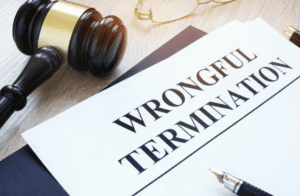 An Employee’s Guide to Sexual Harassment in the Workplace
An Employee’s Guide to Sexual Harassment in the Workplace
No one should have to work in a place where she or he is treated poorly because of a personal characteristic, like sex, race, color, national origin, or religion. And, our laws set out to protect employees from having to work in such places. However, legal protections are nuanced and limited, and can be difficult to understand. The purpose of this piece is to provide straightforward explanations of the law surrounding harassment in the workplace. We will answer questions about types of harassment and the different legal standards that apply in these cases, depending on the type of harassment and the relationship between the victim and the harasser.
What types of behavior are considered harassment under the law?
The law recognizes two types of conduct as harassment: a quid quo pro request and a hostile workplace.
A request for a quid quo pro occurs when the harassment is connected to some kind of “tangible” job benefit or detriment.[1] This type of harassment often takes place when a supervisor offers job benefits in exchange for some kind of sexual favor[2] or a threat of adverse employment action if the employee does not do what is requested.[3] Whether the request is accepted or rejected, it must have been conditioned – either explicitly or implicitly – on some action toward “the employee’s compensation, terms, conditions, or privileges of employment.”[4] These actions often include promotions, bonuses, demotions, and termination of employment. Importantly, the offer or threat is not enough on its own; the tangible employment action must have taken place.[5]
Sometimes harassment occurs even though an employee does not receive an offer or threat in exchange for sexual favors, but instead is subject to abuse in the workplace on the basis of her sex. This type of harassment is recognized under the law as the creation of a hostile workplace. A hostile workplace is created when the abuse the employee experiences is so severe or pervasive that it interferes with her employment.[6] This means that a single instance of abuse, unless it is very extreme, is unlikely to rise to the level of legal harassment. The victim must have believed that the conduct changed what it meant to be employed at the workplace, and an ordinary person with the same job must also be able to view the workplace as hostile. [7][8] Many factors can be considered in determining if a workplace is hostile, including how often the conduct took place, how severe it was, if it was physical or verbal, whether it interfered with the employee’s ability to work,[9] and the power relation between the victim and the harasser.[10]
What are the legal standards for holding an employer liable for sexual harassment?
Protections from sexual – and other types of – harassment are afforded in federal legislation under Title VII of the Civil Rights Act of 1964, commonly referred to simply as “Title VII.” The legal standards for holding an employer liable for sexual harassment under Title VII depend both on the type of harassment and the nature of the employment relationship between the victim and the harasser.
We have already discussed the different types of harassment: quid pro quo and hostile workplace. But, we also need to understand how the law defines who is a supervisor and who is a co-worker.
Who is a supervisor?
Our everyday use of the word “supervisor” can be misleading under the law.[11] We commonly refer to a supervisor as anyone who has control over our employment duties. However, a recent case decided by the Supreme Court of the United States has clarified that, under the law, one must hold the power to hire, fire, promote, reassign, or cause significant changes to benefits to be considered the supervisor of a harassment victim.[12] In other words, being able to assign or withhold duties, without having the power to take one of those “tangible” employment actions, means that employee is not a supervisor.
Who is a co-worker?
Simply put: a co-worker, for the purpose of a harassment claim under Title VII, is any employee who is not a supervisor. That is, a co-worker is another employee who has not been granted the power to make decisions about the tangible employment actions of the victim. This is the case even if the employee can control other aspects of the victim’s employment, like her duties or schedule.
When can an employer be liable for quid quo pro harassment?
Some kind of tangible employment action is required for quid quo pro harassment, and because the definition of a supervisor requires the power to be able to take tangible employment actions, employers will only be liable for quid pro quo harassment when the harasser is a supervisor according to the law. Despite the limited legal definition of a supervisor, quid quo pro harassment is the most direct way for an employer to be held liable for sexual harassment in the workplace.
In cases of quid quo pro harassment, the employer is held strictly liable – that is, automatically liable – for the harassment of the supervisor.[13] This means that the employer is responsible for the actions of the supervisor “whether or not it knew, or should have known, or approved of the supervisor’s actions.”[14] The victim only has to show that her supervisor took a tangible employment action and that action was the completion of an offer or threat for a sexual favor.
When can an employer be liable for a hostile workplace?
Employers can be liable for harassment through the creation of a hostile workplace both when the harasser was a co-worker and a supervisor. But, the legal standards are different depending on this victim-harasser relationship.
When a supervisor creates a hostile workplace, an employer can be held vicariously liable; that is, potentially liable because of the actions of the supervisor. However, unlike in the case of quid quo pro harassment, where the employer can be liable no matter its part in the harassment, in a hostile workplace claim, an employer can avoid liability.[15] In order to escape liability, an employer must show both that it tried to “prevent and correct” the harassment and that the victim did not take advantage of the “preventative or corrective opportunities the employer provided.”[16] This means that, if a victim does not first find and follow the employer’s procedures for harassment, the employer can use that failure to avoid liability for the hostile workplace, even when a supervisor created it.[17]
In the case of a hostile workplace due to the actions of a co-worker, the legal standard is even more “employer-friendly.”[18] An employer will only be liable if it was negligent in preventing or correcting the harassment.[19] In determining whether an employer was negligent, a court can consider “[e]vidence that an employer did not monitor the workplace, failed to respond to complaints, failed to provide a system for registering complaints, or effectively discouraged complaints from being filed.”[20] Additionally, the employer must have known or should have known about the conduct that created the hostile workplace.[21] Essentially, so long as the employer can show that it made some effort to prevent and address the harassment, it will not be liable for the creation of a hostile workplace by a victim’s co-worker.
So, what exactly are the different legal standards?
It can be confusing to have so many different standards depending on the type of sexual harassment and the nature of the relationship of the victim and harasser. This simple chart might help clarify the law.
| Quid Quo Pro | Hostile Workplace | |
| Co-worker | Not applicable. Co-workers cannot take tangible employment actions. | Employer vicariously liable ONLY if negligent. |
| Supervisor | Employer strictly liable for employee’s harassing actions. | Employer vicariously liable for employee’s harassing actions ONLY if unable to assert an affirmative defense. |
[1] Spencer v. General Electric Co., 894 F.2d 651, 658 (4th Cir.1990).
[2] Id. (citing Katz v. Dole, 709 F.2d 251, 254 (4th Cir.1983)).
[3] Burlington Industries, Inc. v. Ellerth, 524 U.S. 742, 751 (1998).
[4] Spencer, 894 F.2d at 658.
[5] Ellerth, 524 U.S. at 753.
[6] Meritor Sav. Bank v. Vinson, 477 U.S. 57, 67 (1986).
[7] Harris v. Forklift Sys., Inc., 510 U .S. 17, 21-22 (1993).
[8] Id.
[9] Id. at 23.
[10] Ziskie v. Mineta, 547 F.3d 220, 228 (4th Cir. 2008).
[11] See Vance v. Ball State Univ., 133 S.Ct. 2434, 2457-58 (J. Ginsberg dissenting).
[12] Vance, v. Ball State Univ., 133 S.Ct. at2434, 2443 (citing Ellerth, 524 U.S. at 761).
[13] Id. at 2448 (citing Ellerth, 524 U.S. at 760-61).
[14] Ellerth, 524 U.S. at 760-61 (quoting Meritor, 477 U.S. at 70-71).
[15] Vance, 133 S.Ct. at 2439 (citing Faragher v. Boca Raton, 524 U.S. 775, 807 (1998) and Ellerth, 524 U.S. at 765).
[16] Id.
[17] It is also important to note that, in addition to following the employer’s procedure, a victim must also first file a charge with the Equal Employment Opportunity Commission (EEOC) or a state fair employment practice agency before a court can consider a Title VII claim. In the D.C. Metropolitan Area there are two EEOC offices, one in D.C. and the other in Baltimore. There are also multiple fair employment practice agencies throughout Virginia and Maryland.[17] And, filing this charge should be done relatively quickly, as victims of sexual harassment only have 300 days from the time of harassing conduct to file charges in the D.C., Virginia, and Maryland, and as little as 180 days for filing charges against employers with less than 15 employers.[17]
[18] This is Justice Ginsberg’s language. Vance, 133 S.Ct. at 2463.
[19] Vance, 133 S.Ct. at 2441 (citing Faragher, 524 U.S. at 789).
[20] Id. at 2453.
[21] Faragher, 524 U.S. at 799; Ellerth, 524 U.S. at 758-59.





